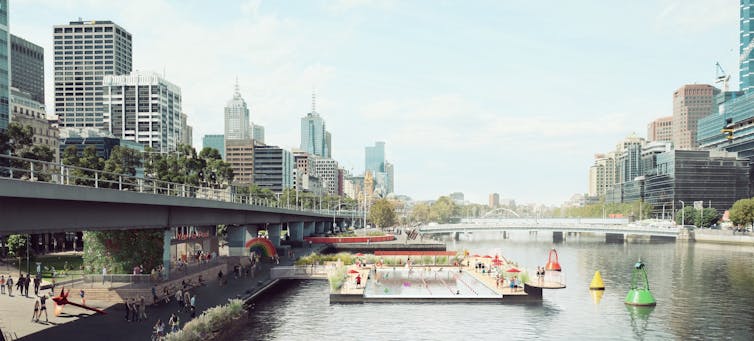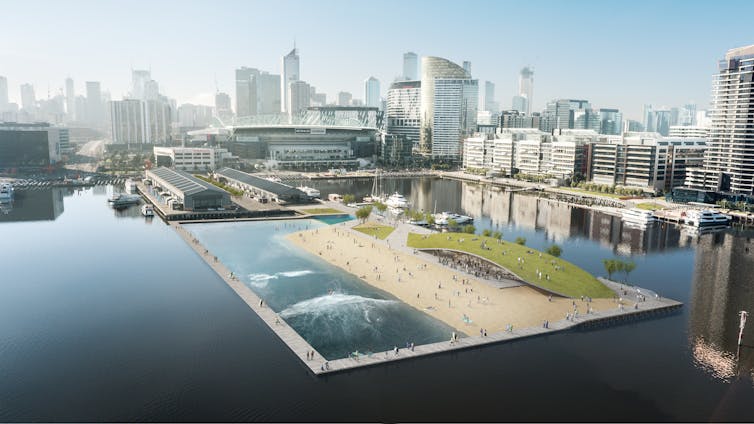Community pool projects show how citizens are helping to build cities
- Written by Timothy Moore, PhD Candidate, Melbourne School of Design, Monash University
Swimming is central to Australian identity, whether at the beach, in a river or a backyard pool or creek. At the heart of Australia’s bathing culture is the public pool. Its persistent popularity is reflected in a raft of recent proposals to construct pools across the country.
Property developer Riverside Marine has proposed building a pool that would float in the Teneriffe section of the Brisbane River. And the Yarra Pools project in Melbourne, which also seeks to create a floating swimming pool on the Yarra River, is gaining momentum through the input of a collection of peak bodies and community organisations.
 Artist’s impression of the Yarra Pool, Melbourne.
Image courtesy of Studio Octopi, Yarra Swim and Picture Plane, Author provided
Artist’s impression of the Yarra Pool, Melbourne.
Image courtesy of Studio Octopi, Yarra Swim and Picture Plane, Author provided
Such realities reflect a growing trend of individual and organisational interests, not local and state governments, leading Australian community construction proposals.
Rise of the public pool
The public pool became embedded in Australia’s cultural consciousness after hundreds of seaside and suburban pools were constructed all over the country in the early to mid 20th century.
Read more: From segregation to celebration: the public pool in Australian culture
This reflected a belief that government should provide amenities for citizens that promoted health, safety and appropriate leisure activities. It was also part of a belief that humankind could control, regulate and tame nature, including water.
With the rise of indoor leisure centres and backyard pools in the 1970s and ’80s, the popularity of outdoor public pools declined. Attendances waned and public funding fell away. This exacerbated under-investment and led to many closures in the 1990s.
But the 21st century has seen a wider global interest in urban pools, water parks and promenades – like Helsinki’s Allas Sea Pool – as part of efforts to make places more healthy and attractive. There is particular interest in the redevelopment of many docks, ports and city beaches in wealthy cities.
 Allas Sea Pool in Helsinki.
Ninara/Flickr
Allas Sea Pool in Helsinki.
Ninara/Flickr
Read more: Why that 'clean swimming pool' smell is actually bad for your health
Popular opinion and public support
The private sector has been active in proposing pool developments. Some design firms and property developers have signalled their interest through what’s called the “render drop”. This is the release to media outlets of an artist’s impression of a project that has a novelty factor, in the hope of gaining traction and public support.
Damian Rogers Architecture and Arup employed the render drop to gain attention for a proposal for a surf pool at Melbourne’s Docklands. But attention for a project does not equate to support for it. A render drop can test popular opinion, but a project put forward this way can fail to achieve engagement with the stakeholders that would have to help plan, deliver, maintain and use the project.
Read more: Why that 'clean swimming pool' smell is actually bad for your health
Community and private interests should work with government from early on in a project’s conception. Yarra Pools has, for instance, had a long road-map for gaining public support for the pool. This includes partnering peak community bodies, engaging with private firms and speaking with governmental organisations.
 Artist’s impression of the proposed surf pool at Docklands, Melbourne.
Image courtesy of Studio Magnified/Aurecon
Artist’s impression of the proposed surf pool at Docklands, Melbourne.
Image courtesy of Studio Magnified/Aurecon
Working together
The visibility of non-government proposals may reflect a sense that governments lack the responsibility, will, finance or imagination to deliver public projects. This makes way for the private and community sectors to meet an untapped demand.
An increase in non-government proposals may also be the result of an increased push from the community and private sectors to be involved in the processes of urbanism.
Though, as architect and historian Hannah Lewi argues in the 2010 book Community: Building Modern Australia (2010), governments weren’t always responsible for urban projects. She writes:
Progress societies and local groups were instrumental in the building of public pools through fundraising to bolster municipal, state and federal government assistance that was typically meagre and stopped short of achieving such a costly undertaking.
Scarce public funding has often pushed the delivery of community infrastructure towards collaboration between community, government and private sectors. In this relationship, if one wants to shift the behaviour of local government – at the very least, to get a pool built – one needs to engage with government rules, regulations and organisational culture from the outset.
Read more: This is what our cities need to do to be truly liveable for all
A community project to create a pool with the input of individuals and organisations shifts the role of the public. They go from being a passive agent, which is consulted at the beginning of the design process, to a potentially ongoing and active participant – or collaborator – in the continuing life of buildings and cities.
This model can also hold governments and private stakeholders to account in the area of project delivery while building trust by opening up the often opaque processes of urban development.
The building of a pool can be part of a larger project of building new civic institutions and networks that fall somewhere between market, state and civil society.
The Conversation is co-publishing articles with Future West (Australian Urbanism), produced by the University of Western Australia’s Faculty of Architecture, Landscape and Visual Arts. These articles look towards the future of urbanism, taking Perth and Western Australia as its reference point. You can read other articles here.
Authors: Timothy Moore, PhD Candidate, Melbourne School of Design, Monash University



















